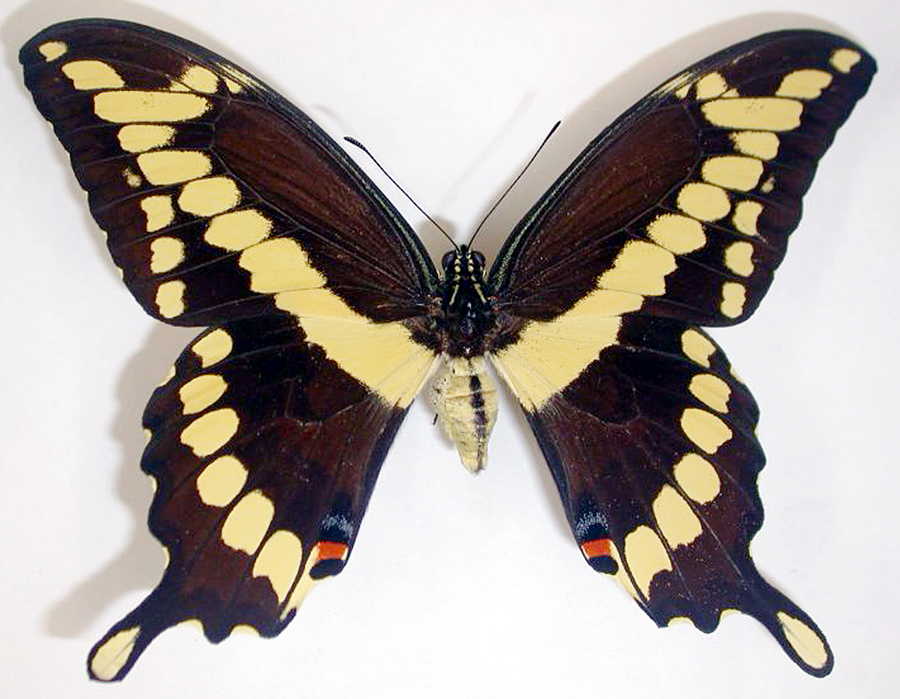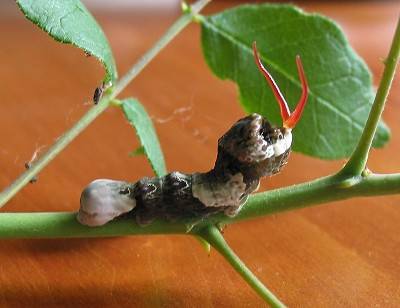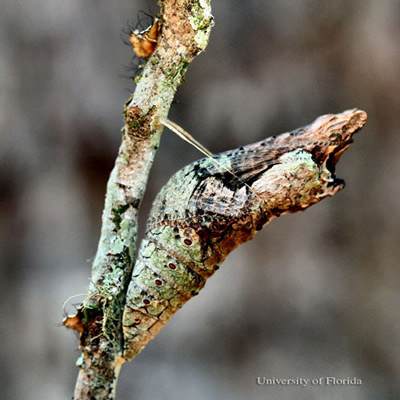Through the corner of your eye, a great splash of color dances across your peripheral vision, flashing like an exotic dervish. The pattern of flight is at once dramatic and delightful—freezing you in place in open-mouthed wonder. Flying high and fast, it’s like some kind of art experience: color and pattern pulsate, shape and texture blur, your eyes struggle to focus. It dips and flits and seems to almost hop through the air, sometimes gliding free and weightless for interminable snatches of time. The Giant Swallowtail butterfly (Papilio cresphontes) is truly a titan. With a wingspan from 4 – 6 inches, it’s capable of startling an unaware gardener or casual hiker. My first sighting of this knockout was unforgettable. Pale lemon yellow, interspersed with smudges of black, blue and orange defines the underbelly while the topside is brown or black with showy diagonal yellow bands across the wings and a yellow “eye” in each wing tail—a real head-turner.
There are many varieties of so-called swallowtail butterflies—they belong to the family Papilionidae. All are large colorful specimens mostly found in the tropics, but the family tree casts its shadow on every continent, except Antarctica. The swallowtails are unique in that even when feeding they continue to flutter their wings. In Texas, you may be familiar with the Pipevine Swallowtail, the Spicebush Swallowtail, Tiger Swallowtail or the Black Swallowtail. The forked appearance of the swallowtails’ hind wings gave rise to the common name—someone obviously thinks they look like the tail of a swallow. To me, they’re little boat oars. Not all members of this family have distinctive swallow-like tail extensions, but our Giant Swallowtail certainly does.
Butterfly aficionados can tell the sex of the Giant Swallowtail by its size and flight pattern. Females are larger, with larger wings, so they get more distance from a wingbeat (and they beat them slower)—making them fly faster. Males, however, beat their smaller wings faster, giving them a “darty” appearance, but they actually fly slower as they patrol pine wood flyways searching for mates. They’re both breathtaking, so I always figure it doesn’t matter if I can tell the sexes apart. . .as long as the butterflies can! The coil of life is more uncertain for butterfly babies; there is no parental protective instinct (only the Hackberry Emperor has been reported to “attack” people who come too close to their host plant, the hackberry tree). Not only must there be a successful mating, but there also must be the right host plant to provide food for newly hatched larvae. Finding the correct food source is critical—without it there will be no next generation. Giant Swallowtails need plants in the citrus family as nurse plants for their young.
Giant Swallowtail eggs are often deposited singly, rather than in clusters, on the topside of a host plant leaf. These eggs are cream or brown in color and are covered in an irregular coating of an orange secretion that looks like an orange peel. Why an orange peel? Perhaps this is a bit of protective deception. In the citrus groves of South Florida, the larvae are known as “orange dogs” because they can defoliate most of an orange tree overnight, earning them pest status in a hurry. To add insult to injury, larval feeding takes place at night when the orange growers are all asleep. Nice. But in Texas, unless you are a citrus farmer from the Lower Rio Grande valley, there is little reason to harbor enmity against this winged beauty.
Giant Swallowtail larvae in this part of Texas get their nourishment mostly from leaves of the Hercules-club or the hoptree (AKA wafer-ash). Larvae will eat with gusto until they are ~ 2 inches long. Some butterfly larvae can grow 100 times their original size. All butterfly larvae are exposed to predation from birds, spiders, wasps, ants and other stuff, so in this part of Texas there can be as many as three broods of Giant Swallowtail a year. Even though the odds seem stacked against success, as you will see, this animal has concocted some seriously cool survival protocols.
The larval stage is a vulnerable period calling for some tough measures. The Giant Swallowtail larva goes through five distinct stages of growth, called instars. The five larval instars differ in appearance but the middle to last versions share a common disgusting trait—they all look like bird shit. Now that’ll definitely make you look elsewhere for a meal! Younger instars are smaller and less convincing. This is a form of mimicry designed to protect larvae from becoming lunch—mimicry is a common arrow in the survival quiver of the Giant Swallowtail. For example, mature larvae usually rest on stems or leaf petioles, but younger larvae often rest in plain view on the upper surfaces of leaves. . . where you would expect to find bird poop.
But wait. . .there’s more! As the larva grows, the mimicry grows even more eloquent. Some people believe older instars resemble small snakes. A naturalist friend from another chapter has raised adult Swallowtails from eggs—she sees little resemblance from Giant Swallowtail larvae and holds that other swallowtail varieties make more convincing “serpents.” Still, likeness is in the eye of the beholder I suppose. As the larvae grow, they develop prominent thoraxes (head of the snake?) and sometimes rest in serpentine poses with the thorax bent upwards (a snake head ready to strike?). The markings on the “head” could be construed to resemble scales to a casual observer. To complete the ruse, mimicry is taken to new heights. All papilionid caterpillars have this repugnant organ known as an osmeterium. A slick wet-looking thing, it normally remains hidden, but when the larva feels threatened it sends the organ out through a dorsal groove by inflating it with fluid. Voila! Could it be mistaken for a pink forked snake tongue? This “tongue” contains a highly noxious, pungent mixture of acidic chemicals that smells like the south end of a north-bound skunk. What matters to the larva, of course, is not whether its appearance fools you but whether it deters predators. A splendidly effective artifice that gives predators pause. . .if we could do it, I bet it would at least get us off jury duty!
If you think humans have it tough growing up, as in “the terrible twos” or the awkward teenage years, it’s nothing compared to butterfly offspring! Giant Swallowtail caterpillars molt up to five times to accommodate their surging bodies. . . then they have to pull off a quick-change in a chrysalis (pupa stage). The head end of the chrysalis is attached to the host by a silken thread and the tail end is attached directly, like Velcro, strung up in suspended torpor. So there they are. . . having led an active life, now they are relegated to just hanging out. The chrysalis stage usually only takes from 10-12 days, but in the fall pupas may stay in the chrysalis throughout the winter and emerge as butterflies the following spring. Imagine being confused with bird crap all your life, then going to bed in late winter and waking up next spring as this magnificent, bedazzling creature. Metamorphosis is beyond bizarre. . .it’s sublime.
Everyone accedes to the four stages of development in the butterfly life cycle, but I still cannot get my mind around the immensity of this transformation. What forces of nature are brought to bear on this process? What are the factors that determine the sequencing and timing? Such a miracle is uniformly accepted as undistinguished—what a huge misunderstanding! The chrysalis just dangles there, inanimate. It looks like nothing is going on but big changes are happening inside. Special cells that were present in the larva are growing rapidly. They will become the legs, wings, eyes and other parts of the adult butterfly. And what a magnificent butterfly the Giant Swallowtail is!
It won’t be long now. The month of May is when the Giant Swallowtail typically emerges in these parts. So, I would like to ask you to do yourself a favor. If you haven’t yet seen a Giant Swallowtail on the wing, make an effort to learn what you’re looking for and get out there and find one. Chances of happening upon or identifying a larva are less likely—but it can be done. Giant Swallowtails are right here in Central Texas, part of the native bounty, just waiting to make your day. But, just so you know. . . dressed in splendor, gay and glittering, the adult butterfly’s purpose is to reproduce and die within a few weeks. They deserve your attention and appreciation. Just like some of nature’s other delicates—orchids and rainbows—I guess they’re just too beautiful to last.






